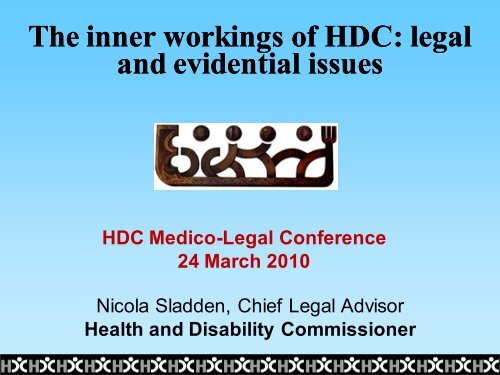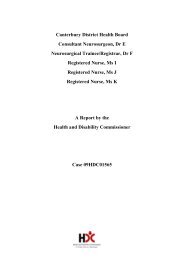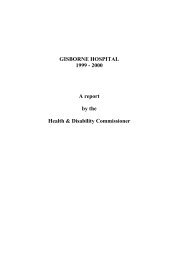The inner workings of HDC - legal & evidential issues - Health and ...
The inner workings of HDC - legal & evidential issues - Health and ...
The inner workings of HDC - legal & evidential issues - Health and ...
You also want an ePaper? Increase the reach of your titles
YUMPU automatically turns print PDFs into web optimized ePapers that Google loves.
<strong>The</strong> <strong>inner</strong> <strong>workings</strong> <strong>of</strong> <strong>HDC</strong>: <strong>legal</strong><br />
<strong>and</strong> <strong>evidential</strong> <strong>issues</strong><br />
<strong>HDC</strong> Medico-Legal Conference<br />
24 March 2010<br />
Nicola Sladden, Chief Legal Advisor<br />
<strong>Health</strong> <strong>and</strong> Disability Commissioner
Quis custodiet ipsos custodes?<br />
Who will watch the watchers themselves?
Avenues <strong>of</strong> review<br />
• Internal review<br />
• Ombudsman review<br />
• Judicial review<br />
• No right <strong>of</strong> appeal
Internal review – high threshold
Internal review – two pronged test<br />
• Has the <strong>HDC</strong> made an error –<br />
either procedural or substantive?<br />
• What is the significance <strong>of</strong> the<br />
error – does the overall justice<br />
require the matter to be reopened?
Case A – <strong>The</strong> complaint<br />
• A general surgeon diagnosed a large pre<br />
cancerous lesion <strong>and</strong> performed surgery<br />
to remove it.<br />
• <strong>The</strong> patient had ongoing difficulties <strong>and</strong><br />
further surgery was required.
Case A – <strong>The</strong> investigation<br />
• <strong>The</strong> Commissioner commenced an<br />
investigation into the appropriateness <strong>of</strong> the<br />
care provided by Dr B.<br />
• Independent expert advice was provided by a<br />
general surgeon — operation was inadequate.<br />
• <strong>HDC</strong> concluded there were deficiencies in the<br />
surgeon’s management — breached Right<br />
4(1).
Case A – <strong>The</strong> subsequent challenge<br />
• Surgeon disagreed with the findings<br />
• Accepted process was fair<br />
• Provided additional information<br />
• Operation note <strong>and</strong> histology report from<br />
subsequent surgery — no evidence <strong>of</strong> residual<br />
cancer<br />
• Surgeon submitted expert advice that the<br />
surgery was adequate.
Case A – <strong>The</strong> internal review<br />
• Compelling new information?<br />
• Positive outcome does not excuse poor care (in<br />
the same way a poor outcome is not inculpatory).<br />
• Expert gives a tentative opinion on the adequacy<br />
<strong>of</strong> the surgery in light <strong>of</strong> the final histology.<br />
• No basis for reopening investigation.<br />
―And <strong>of</strong>ten times excusing <strong>of</strong> a fault doth make the<br />
fault the worse by the excuse.‖<br />
Shakespeare, King John
Ombudsman review<br />
Review de novo or process review?<br />
• Unnecessary duplication<br />
• Lack <strong>of</strong> expertise<br />
• No right <strong>of</strong> appeal<br />
Role <strong>of</strong> the Ombudsman is to examine<br />
the fairness <strong>and</strong> effectiveness <strong>of</strong> the<br />
process.
Case B – Key facts<br />
• <strong>The</strong> patient had colon cancer <strong>and</strong><br />
extensive secondary cancers in the liver.<br />
• A bariatric <strong>and</strong> liver surgeon<br />
recommended Selective Internal<br />
Radiation <strong>The</strong>rapy (SIRT) <strong>and</strong> Hepatic<br />
Artery Chemotherapy (HAC).<br />
• Cost <strong>of</strong> treatment – approx $40 000 –<br />
self funded.
Case B – Key facts<br />
Treatments delivered<br />
through a surgically<br />
implanted port into the<br />
hepatic artery which<br />
serves the liver.
Case B – Key facts<br />
• <strong>The</strong> patient received his first SIRT<br />
treatment in November 2007.<br />
• By June 2008, the patient’s disease was<br />
progressing.<br />
• Repeat SIRT treatment was discussed.<br />
• Mr A was concerned about costs.<br />
• Agreed to proceed in July 2008.
Case B – Key facts<br />
• Initial testing revealed the port was not<br />
working.<br />
• An alternative procedure was urgently<br />
discussed <strong>and</strong> agreed by Mr A.<br />
• Urgency arose because the radioactive<br />
material decayed quickly.<br />
• <strong>The</strong> alternative process would cost an<br />
addition $5–7,000.
Case B – Key facts<br />
• A few days after the repeat treatment, Mr<br />
A expressed concern about the additional<br />
cost.<br />
• He said he was unaware <strong>of</strong> the potential<br />
for the port to fail <strong>and</strong> the medical <strong>and</strong><br />
financial consequences <strong>of</strong> it.<br />
• After a short respite, Mr A’s condition<br />
deteriorated <strong>and</strong> he died in February 2009.
Case B – <strong>HDC</strong> investigation<br />
• 25–33% chance overall <strong>of</strong> failure <strong>of</strong> port.<br />
• Independent expert on appropriateness <strong>of</strong><br />
care <strong>and</strong> adequacy <strong>of</strong> information provided:<br />
―It could also be said that it would have been<br />
better if the information booklet had been more<br />
specific on the possibility <strong>of</strong> device malfunction.<br />
This could be added for future editions. Doctors<br />
perhaps tend to accept as given the fact that<br />
any plastic tube may block, fall out or become<br />
infected but patients may not be aware <strong>of</strong> this.‖
Case B – <strong>HDC</strong> findings<br />
Dr B — breach — Right 6(1)(b)<br />
• <strong>The</strong>re was a risk <strong>of</strong> failure <strong>of</strong> the port.<br />
• Dr B should have discussed the possibility,<br />
<strong>and</strong> cost implications.<br />
• This was information that a reasonable<br />
person in Mr A’s circumstances would<br />
expect to receive.
Case B – <strong>HDC</strong> recommendations<br />
• Amend his patient information booklet.<br />
• Pay Mrs A $5,000 towards the<br />
additional costs following the failure <strong>of</strong><br />
the port.<br />
• An anonymised copy <strong>of</strong> report be placed<br />
on website for education purposes.
Case B – Judicial review<br />
• <strong>The</strong> surgeon challenged the decision on the<br />
grounds <strong>of</strong> bias, irrationality,<br />
unreasonableness, unfairness <strong>and</strong> breach <strong>of</strong><br />
statutory duty.<br />
• <strong>HDC</strong> submitted that the challenge ―was<br />
dressed in the clothes <strong>of</strong> judicial review‖ but<br />
was in substance an appeal against the<br />
Commissioner’s decision.<br />
• St<strong>and</strong>ard <strong>of</strong> review applied to decision?
Case B – Judicial review<br />
• Simple straightforward complaint system.<br />
• Prescribed process has a high level <strong>of</strong> ―fairness‖<br />
attached.<br />
• Commissioner has high level <strong>of</strong> expertise in the<br />
field.<br />
• Commissioner’s opinion does not directly affect<br />
the <strong>legal</strong> rights or liabilities <strong>of</strong> the provider.<br />
• It is an opinion albeit well informed but where<br />
there may be genuine scope for disagreement.
Case B – St<strong>and</strong>ard <strong>of</strong> review<br />
• Tenor <strong>of</strong> legislation — ―hard‖ look judicial<br />
review is not appropriate.<br />
– Was there a rational factual basis for the<br />
Commissioner’s conclusion?<br />
– Was the conclusion open to the Commissioner<br />
on the facts?<br />
‣ If so, the grounds <strong>of</strong> the review could not<br />
succeed. Not a fact based appeal.
Case B – No grounds for review<br />
• <strong>The</strong>re was information on which the<br />
Commissioner could logically conclude that<br />
the patient should have been told <strong>of</strong> the<br />
potential failure <strong>of</strong> the port <strong>and</strong> additional cost<br />
for the alternative method.<br />
• <strong>The</strong> Commissioner’s opinion could not be<br />
successfully challenged.
Case B – Publicity<br />
• Dr B sought an order prohibiting publication <strong>of</strong> the<br />
anonymised opinion because some medical<br />
practitioners at least would identify Dr A.<br />
• ―Such is life in New Zeal<strong>and</strong>‖ <strong>and</strong> is not a reason<br />
to compromise the important educative function<br />
<strong>of</strong> those opinions.<br />
• Name suppression not granted – open justice –<br />
no special circumstances.<br />
• Stubbs v <strong>Health</strong> <strong>and</strong> Disability Commissioner<br />
Young J, High Court Wellington, CIV 2009-485-2146, 8 February 2010.
Conclusion<br />
• <strong>The</strong>re is no right <strong>of</strong> appeal from the<br />
Commissioner’s decision.<br />
• <strong>The</strong> Ombudsmen <strong>and</strong> Court showed a high<br />
degree <strong>of</strong> deference to the expertise <strong>and</strong><br />
specialist knowledge <strong>of</strong> the Commissioner.<br />
• An opinion that a provider has breached the<br />
Code is something ―the Commissioner is<br />
well if not uniquely qualified to express‖.
So — who is watching the<br />
watchdog?<br />
• Public watchdogs are subject to considerable<br />
public scrutiny.<br />
• <strong>The</strong>re are safeguards to ensure fairness.<br />
• So how does <strong>HDC</strong> measure up as a watchdog ?
www.hdc.org.nz
















